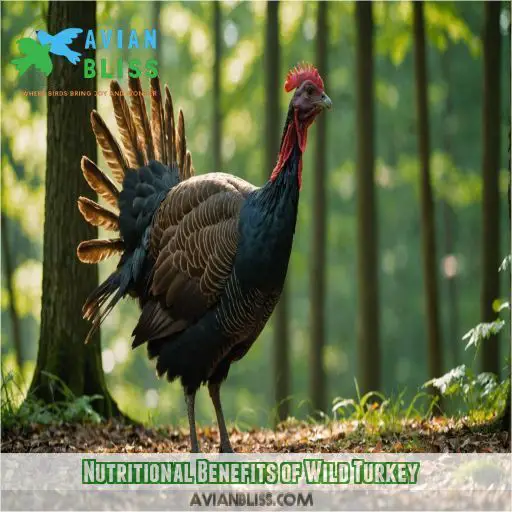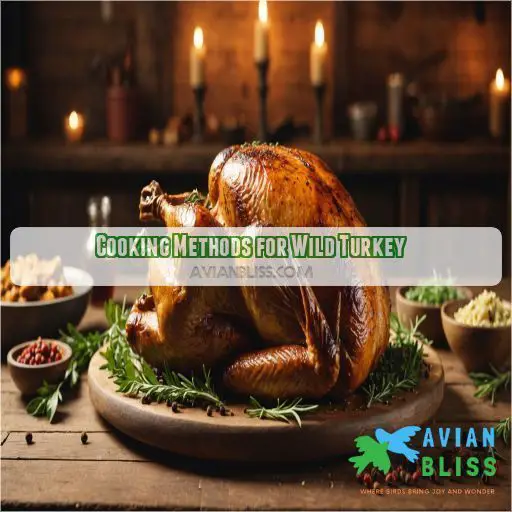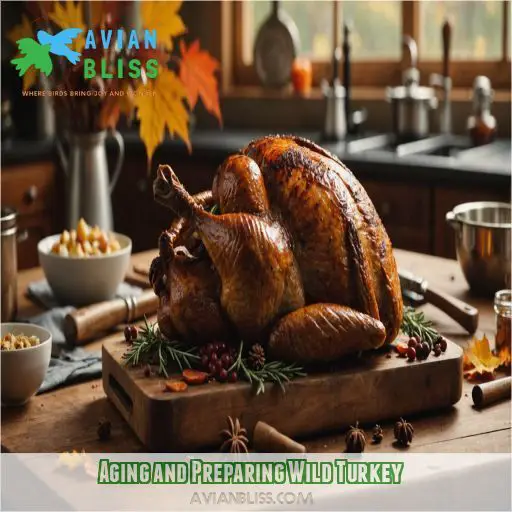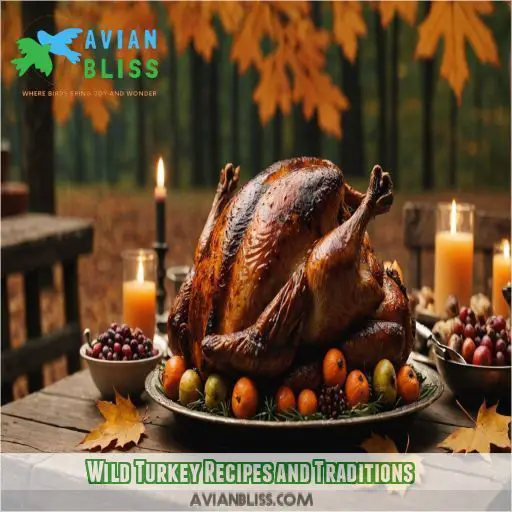This site is supported by our readers. We may earn a commission, at no cost to you, if you purchase through links.
 You’re wondering, can you eat wild turkey? The answer is a resounding yes. As long as you handle and cook it properly, Wild Turkey is a safe and delicious addition to your menu.
You’re wondering, can you eat wild turkey? The answer is a resounding yes. As long as you handle and cook it properly, Wild Turkey is a safe and delicious addition to your menu.
Wild turkey is a leaner protein source than domestic turkey, packed with vitamins and minerals like niacin, vitamin B6, and phosphorus. With its rich, intense flavor, you can cook it just like a traditional Thanksgiving turkey.
You can roast it, grill it, or even deep-fry it. So, go ahead and get creative with that wild turkey. You’re just a few cooking tips away from a truly unforgettable meal.
Table Of Contents
- Key Takeaways
- Wild Turkey Meat Safety
- Nutritional Benefits of Wild Turkey
- Best Parts of Wild Turkey to Eat
- Cooking Methods for Wild Turkey
- Aging and Preparing Wild Turkey
- Wild Turkey Recipes and Traditions
- Frequently Asked Questions (FAQs)
- Is wild turkey meat safe to eat?
- What is the best part of the wild turkey to eat?
- Is wild turkey good for you?
- Is turkey meat safe to eat?
- Is wild turkey hunting regulated in all regions ?
- Can wild turkey be used in traditional recipes ?
- What are the benefits of eating wild turkey organs ?
- How does wild turkey compare to domestic turkey taste ?
- Can wild turkey be stored in the freezer long-term ?
- Conclusion
Key Takeaways
- You can eat wild turkey, and it’s a fantastic source of protein. As long as you handle and cook it properly, you’re in for a treat. With its rich, intense flavor, you can cook it just like a traditional Thanksgiving turkey—roast it, grill it, or even deep-fry it.
- Wild turkey is a leaner protein source than domestic turkey, packed with vitamins and minerals like niacin, vitamin B6, and phosphorus. It’s also lower in fat and calories, making it a great choice for health-conscious meat lovers.
- When handling wild turkey, prioritize sanitation to prevent cross-contamination. Store the bird in a sealed container, refrigerate it at 40°F (4°C), or freeze it at 0°F (-18°C). Thaw frozen turkey in the refrigerator or cold water, changing the water every 30 minutes.
- To ensure food safety, cook wild turkey to an internal temperature of 165°F (74°C). Don’t overcrowd your cooking surface, and use separate utensils and cutting boards to prevent cross-contamination. By following these guidelines, you’ll enjoy a safe and savory meal that’s sure to impress your friends and family.
Wild Turkey Meat Safety
You’re probably wondering if it’s safe to eat wild turkey – and the answer is yes, as long as you handle and cook it properly. From field dressing to cooking methods, we’ll walk you through the essential guidelines to make sure your wild turkey is delicious and safe to eat.
Handling and Storage Guidelines
When handling wild turkey, prioritize sanitation to prevent cross-contamination. Store the bird in a sealed container, refrigerate at 40F (4C), or freeze at 0F (-18C). Thaw frozen turkey in the refrigerator or cold water, changing the water every 30 minutes. Handle the bird carefully to make sure you have a safe, delicious meal.
Cooking Methods to Ensure Food Safety
When cooking wild turkey, prioritize food safety to avoid a fowl move. To make sure you have a safe and savory meal, follow these guidelines:
- Cook to an internal temperature of 165F (74C)
- Prevent cross-contamination with separate utensils and cutting boards
- Handle the bird safely to prevent accidents
- Store leftovers properly to avoid food poisoning
- Don’t overcrowd your cooking surface to make sure it cooks evenly
Common Foodborne Illnesses From Wild Turkey
When handling wild turkey, you’re at risk for foodborne illnesses like Salmonella, E. coli, Campylobacter, Listeria, and Trichinosis. To minimize risk, follow proper cooking and storage procedures.
| Foodborne Illness | Symptoms | Prevention |
|---|---|---|
| Salmonella | Diarrhea, fever, cramps | Cook to 165°F |
| E. coli | Diarrhea, UTIs, pneumonia | Handle safely, cook thoroughly |
| Campylobacter | Diarrhea, fever, cramps | Cook to 165°F, handle safely |
Importance of Proper Field Dressing
Now that we’ve covered common foodborne illnesses, let’s talk about proper field dressing. This important step helps keep things clean and safe when you’re handling wild turkey meat. By doing it right, you’ll keep the quality of your hard-earned harvest high and enjoy a healthier, more flavorful meal.
Nutritional Benefits of Wild Turkey
You’re probably wondering if wild turkey is good for you – and the answer is yes! Wild turkey is a nutrient-rich food that offers several health benefits, including being a lean protein source, rich in vitamins and minerals, and lower in fat compared to domestic turkey.
Protein Content and Lean Meat
If you’re looking for protein, wild turkey really delivers! With a whopping 25 grams of protein and only 1 gram of fat per 100 grams of breast meat, this lean bird is a nutritional powerhouse. Its active lifestyle and diverse diet make it a great choice for health-conscious meat lovers.
Comparison to Domestic Turkey Nutrition
When comparing wild turkey to domestic turkey, you’ll notice a difference in fat content and protein. Wild turkey generally has less fat and calories, but similar protein content. A 100g serving of wild turkey breast contains 25g of protein and 1g of fat, making it a leaner choice (Source).
Vitamins and Minerals in Wild Turkey
Wild turkey is a great source of vitamins and minerals. Here are some key nutrients you’ll find in wild turkey:
- Niacin: supports healthy skin and digestion
- Vitamin B6: helps with brain function and immunity
- Phosphorus: essential for bone health
- Selenium: acts as an antioxidant in the body
Health Benefits of Consuming Wild Turkey
Consuming wild turkey offers numerous health benefits. As a lean protein source, it provides essential amino acids while being low in saturated fats. Rich in heart-healthy omega-3s and iron, wild turkey is an excellent choice for those seeking a nutritious and flavorful alternative to domestic meat.
Best Parts of Wild Turkey to Eat
If you’re thinking about cooking up wild turkey, you’ll want to know which parts are the most tender and flavorful. From breast meat to dark meat, and even organs and giblets, we’ll explore the best parts of wild turkey to eat and how to make the most of your harvest.
Breast Meat Vs. Dark Meat
Wild turkey: breast meat or dark meat? It’s a classic debate that boils down to personal taste, but here are three key differences to keep in mind:
- Flavor: Dark meat has a richer, gamier taste, while breast meat is milder.
- Texture: Breast meat is leaner and firmer, while dark meat is juicier and softer.
- Nutrition: Both breast and dark meat are packed with protein, but breast meat has fewer calories and less fat.
Tender and Flavorful Cuts
Looking for tender and flavorful cuts of wild turkey? You have options! Opt for the oyster thighs, tenderloins, or breast meat for a leaner choice. Try braising or slow-cooking to lock in juices and flavors. Your taste buds (and your guests) will thank you!
Using Organs and Giblets in Cooking
Now that you’ve got the tender cuts, don’t toss those organs and giblets! Use them to make a rich giblet stock, savory heart recipes, or creamy liver pâté. The gizzard adds a delightful texture to soups, while the neck makes a fantastic broth – get creative with wild turkey giblets!
Creative Recipes for Wild Turkey Parts
Get creative with wild turkey parts! Try making giblet stuffing, turkey feet soup, or even turkey heart skewers. For a real showstopper, use wild turkey wings in a mouthwatering offal recipe. As a wild game chef, don’t be afraid to experiment and find your new favorite dish!
Cooking Methods for Wild Turkey
You’re ready to cook your wild turkey, but you’re not sure where to start – don’t worry, we’ve got you covered! From roasting and grilling to slow cooking and braising, we’ll walk you through the best cooking methods to bring out the rich, intense flavor of your wild turkey.
Roasting and Grilling Techniques
Now that you’ve chosen the best parts of your wild turkey, it’s time to fire up the grill or oven! For roasting, preheat to 425°F (220°C). Grill over medium-high heat, about 375°F (190°C). Baste with your favorite marinade every 20 minutes to keep it juicy and flavorful.
Slow Cooking and Braising Methods
To get the most out of wild turkey, try slow cooking and braising methods. These techniques tenderize the meat, enhance the flavor, and make it fall-apart delicious. Here are some expert tips to get you started:
- Brown the bird in a skillet before slow cooking for a richer flavor
- Use a slow cooker or Dutch oven to cook the turkey low and slow
- Add aromatics like onions, carrots, and celery for added depth of flavor
- Cook the turkey until it reaches an internal temperature of 165F for food safety
Brining and Marinating for Moisture
Now that you’ve mastered slow cooking, let’s talk brining and marinating! For wild turkey, a brine with 1-2% salt content for 24 hours can work wonders. Alternatively, marinate with acidic ingredients like vinegar or citrus for added moisture and flavor. Experiment with different brining temperatures and marinating flavors to find your sweet spot!
Tips for Cooking Wild Turkey Breasts
Now that you’ve brined your wild turkey, it’s time to cook those breasts! To avoid dryness, cook them to an internal temperature of 165°F. Don’t overcook, as this can make the meat tough. Your goal is a juicy, flavorful breast with a tender texture.
Aging and Preparing Wild Turkey
As you get ready to cook your wild turkey, you’ll want to think about the importance of aging it first.
This process allows the natural enzymes in the meat to break down, making it more tender and flavorful.
Why Aging is Important for Flavor
When you cook wild turkey, you’ll find that aging is key to bringing out the best flavor. Enzyme activity breaks down muscle tissue, making the meat more tender and developing a rich, gamey flavor. This process is essential for getting that perfect, fall-apart texture that’ll make your taste buds dance!
How to Age Wild Turkey Safely
Now that you know why aging is vital for flavor, let’s get to the nitty-gritty of how to age wild turkey safely. Here are some key considerations:
- Store the bird in a breathable bag or wrap to prevent moisture buildup
- Keep it in a cool, dry place (around 38-40F) to slow bacterial growth
- Allow air to circulate around the bird to promote even drying
- Monitor the bird’s condition daily to prevent spoilage
Plucking, Gutting, and Cleaning the Bird
Now that you’ve aged your wild turkey, it’s time to pluck, gut, and clean it. Here’s a step-by-step guide to help you prepare your bird for cooking:
| Step | Task | Tips and Tools |
|---|---|---|
| 1 | Pluck feathers | Use gloves, a sharp knife, and feather removal tips to avoid damaging the skin. |
| 2 | Gut and clean | Wear rubber gloves, and use bird cleaning tools to prevent contamination. |
| 3 | Rinse and dry | Pat dry with paper towels to prevent bacterial growth. |
Remember to always follow proper Food Safety guidelines when handling wild game.
Preparing Wild Turkey for Cooking
- Rinse and pat dry: Remove any remaining feathers or debris.
- Brine or marinate: Add flavor and tenderize the meat.
- Season and stuff: Get creative with herbs and spices.
- Truss and tie: Secure the legs for even cooking.
Wild Turkey Recipes and Traditions
As you get ready to indulge in the rich flavor of wild turkey, you’ll want to explore the various recipes and traditions that showcase its unique taste. From classic maple chipotle turkey to hearty soups and stews, we’ll guide you through the best ways to prepare and enjoy this delicious game bird.
Classic Maple Chipotle Turkey Recipe
Now that you’ve aged and prepared your wild turkey, it’s time to get creative! Try a classic maple chipotle turkey recipe, blending the sweetness of maple syrup with the smokiness of chipotle peppers. This sweet and spicy combo will elevate your wild game cooking to a whole new level.
Traditional Thanksgiving Recipes
Now that you’ve mastered the classic maple chipotle turkey recipe, let’s talk traditional Thanksgiving recipes. Here are three mouthwatering ideas to complement your wild turkey:
- Wild Turkey Stuffing: Add sausage, apples, and herbs for a savory twist.
- Cranberry Sauce Variations: Try adding orange zest or cinnamon for a unique flavor.
- Pie Recipes: Pair your wild turkey with a classic pumpkin or sweet potato pie.
Using Wild Turkey in Soups and Stews
You can discover the rich flavor of wild turkey by using it in soups and stews. Try simmering the carcass to create a savory wild turkey stock or broth, then add veggies and herbs for a hearty stew. This way, you’ll show respect for the bird and savor every bite.
Creative Ways to Serve Wild Turkey
Get creative with wild turkey! Try making tacos, chili, or smoked wild turkey for a flavor boost. You can also turn it into burgers or sausage for a tasty twist. Wild game cooking has a significant impact on bringing people together, and wild turkey is a delicious contribution.
Frequently Asked Questions (FAQs)
Is wild turkey meat safe to eat?
Food for thought – or should I say, food on the table? Yes, wild turkey meat is safe to eat, but handle it with care, storing it properly and cooking it to an internal temperature of 165°F.
What is the best part of the wild turkey to eat?
Regarding wild turkey, you’ll want to aim for the thighs and legs – they’re darker, stronger, and packed with flavor. These parts are perfect for slow cooking, making them tender and juicy.
Is wild turkey good for you?
When you take a bite out of the wild side, you’ll discover that wild turkey is a leaner, more muscular option, packed with 25 grams of protein and only 1 gram of fat per 100 grams.
Is turkey meat safe to eat?
You’re wondering if turkey meat is safe to eat? Generally, yes, as long as it’s handled, stored, and cooked properly, you’re good to go. Just remember to cook it to an internal temperature of 165 degrees Fahrenheit.
Is wild turkey hunting regulated in all regions ?
You’re curious about wild turkey hunting regulations. Investigating this, you’ll find that while some regions have strict rules, others may have more lenient laws, so you should check local regulations before heading out on a hunt.
Can wild turkey be used in traditional recipes ?
You can definitely use wild turkey in traditional recipes, but keep in mind it has a stronger flavor and firmer texture than domestic turkey. It pairs well with bold ingredients and slow-cooking methods (Source).
What are the benefits of eating wild turkey organs ?
When you eat wild turkey organs, you’re getting a nutrient-rich bonus! The gizzard, heart, and liver are packed with protein, vitamins, and minerals, making them a healthy and delicious addition to your meals.
How does wild turkey compare to domestic turkey taste ?
Get ready for a flavor explosion! Compared to domestic turkey, wild turkey is like a bold, adventurous cousin – with a richer, more intense taste, firmer texture, and a hint of gaminess that’s sure to tantalize your taste buds.
Can wild turkey be stored in the freezer long-term ?
You can store wild turkey in the freezer long-term, but make sure to thoroughly wash and dry the bird first, then wrap it tightly to prevent freezer burn, and aim for 0°F (-18°C) or below.
Conclusion
Now that the cat’s out of the bag – or should I say, the turkey’s out of the woods – you know the answer to the burning question: can you eat wild turkey? With its impressive nutritional profile, rich flavor, and versatility in cooking, wild turkey is a culinary gem waiting to be devoured. So go ahead, get creative, and gobble up the goodness – your taste buds and body will thank you!









